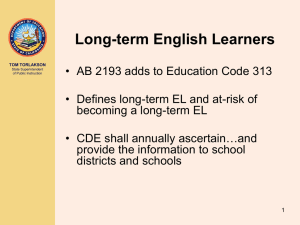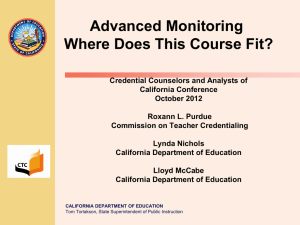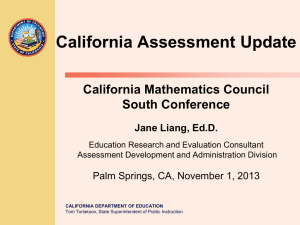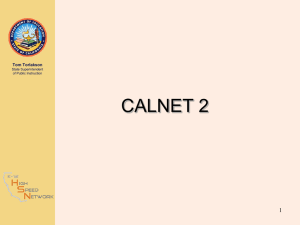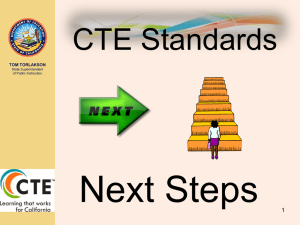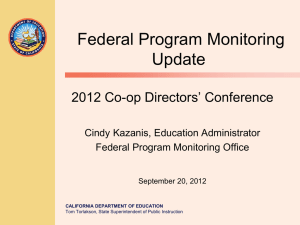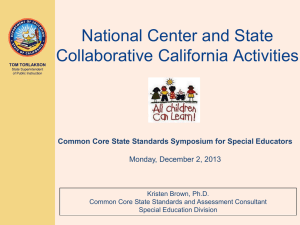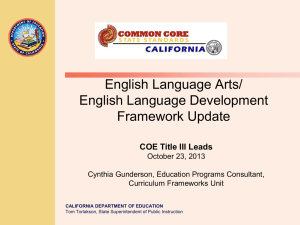PowerPoint Template - Forms (CDE Intranet)
advertisement
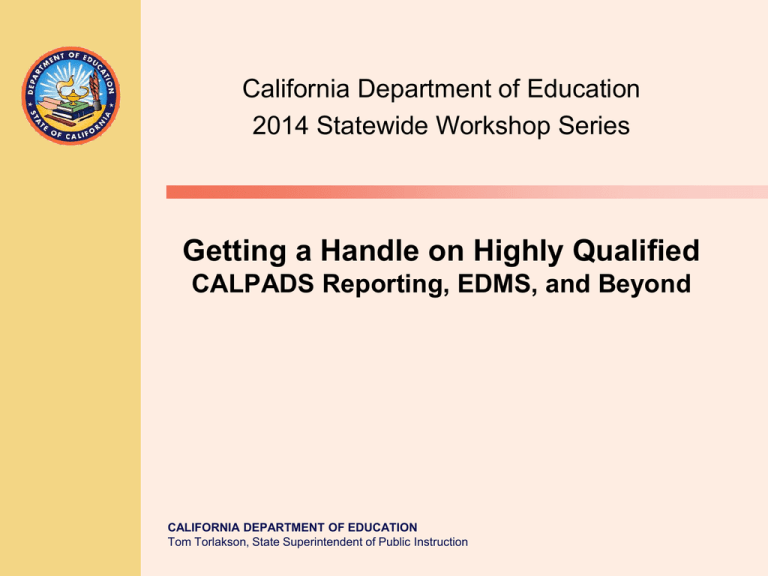
California Department of Education
2014 Statewide Workshop Series
TOM TORLAKSON
State Superintendent
of Public Instruction
Getting a Handle on Highly Qualified
CALPADS Reporting, EDMS, and Beyond
CALIFORNIA DEPARTMENT OF EDUCATION
Tom Torlakson, State Superintendent of Public Instruction
Issues and Answers
TOM TORLAKSON
Title II Leadership Office
State Superintendent
of Public Instruction
Ron Taylor, Education Administrator I
916-323-4819
Lynda Nichols, M.Ed., Education Consultant
916-323-5822
Kelly Heffington, Program Analyst
916-324-5689
Caitlin Stephens, Office Technician
916-445-7331
CALPADS Office
Brandi Jauregui, Staff Information Systems Analyst
916-327-7367
TOM TORLAKSON
State Superintendent
of Public Instruction
The most terrifying words in the English language….We are from the CDE and
we'd like to talk about reporting…
Why am I here…what have we done…what do we do now?
Why am I Here?
TOM TORLAKSON
State Superintendent
of Public Instruction
Required To Be Here
Suggest You Be Here
Failed to Report EDMS
data for three years
Failed to Report EDMS for
two years
• 2011–12
• 2012–13
• 2013–14
Mandatory to prevent Title
II, Part A funds from being
frozen
Reported less than 50%
HQT via CALPADS
• 2012–13
• 2013–14
Putting your Title II, Part A
funds at risk
Reported less than 75% HQT
via CALPADS
• 2013–14
• 2013–14
Or…You responded to the Statewide Invitation
because you wanted to be here!
What Have We Done?
TOM TORLAKSON
State Superintendent
of Public Instruction
More than likely…..
• Reported incorrectly on CALPADS
– Course codes don’t match
– Indicated a class was NOT NCLB when it
was
– Indicated a teacher was NOT HQT when
they were
– Hired non-HQ teachers
Or as simple as
– Failed to report required data
What Do We Do Now?
TOM TORLAKSON
State Superintendent
of Public Instruction
• Establish policies to
ensure timely
reporting….CALPADS
and EDMS
• Establish policies to
ensure accurate
reporting….NEVER
“certify” unchecked
submissions
• Send credentialing
analyst(s) to CCAC
conference EACH
year in Sacramento
….use Title II funds
• Never use Report 3.5
(NCLB Core Course
Section) to verify
HQT….use 4.3 (Staff
Teaching Assignment
Detail)
TOM TORLAKSON
State Superintendent
of Public Instruction
Highly Qualified Teacher
Data in the
California Longitudinal Pupil
Achievement Data System
CALIFORNIA DEPARTMENT OF EDUCATION
Tom Torlakson, State Superintendent of Public Instruction
Ok… I know one of you changed that
code
Hum…wonder what’s for lunch?
TOM TORLAKSON
State Superintendent
of Public Instruction
Let's see…where can I stick this
class?
CALPADS…Course Codes…..and NCLB
Defining course codes
Security Roles in CALPADS
TOM TORLAKSON
State Superintendent
of Public Instruction
• There are three basic levels of security roles for LEAs in
CALPADS.
– Administrative - CALPADS LEA Administrator
(usually in data or information technology)
• Responsible for assigning school level user
accounts
– Data submission – Program-level staff
• Can only submit and update data
– Data certification – Superintendent-level staff
• Responsible for reviewing and certifying data in
certification reports
• You may not have access, but your CALPADS LEA
Administrator knows who does.
TOM TORLAKSON
State Superintendent
of Public Instruction
Data Submission
How are HQT Data Submitted in
CALPADS?
TOM TORLAKSON
State Superintendent
of Public Instruction
• Fall 2 Submission
– Course Section File
• State Course Code – State Level “Course”
name
• Local Course Name – Your local course name
• NCLB Core Course Instructional Level –
Elementary/Secondary/Not a Core Course
• Highly Qualified Teacher (HQT) Competency
Code – How a teacher is or is not highly
qualified
Definition of an NCLB Core Course
in CALPADS
TOM TORLAKSON
State Superintendent
of Public Instruction
• Falls into one of the NCLB
Core Content Areas
based on the State
Course Code
• Flagged as
– Elementary Core or
– Secondary Core
• State course codes that
are designated as
“Unknown” can also be
flagged as
– Core (Elem. Or Sec.)
or
– Not Core
at the discretion of the LEA
How are HQT Data Submitted in
CALPADS?
TOM TORLAKSON
State Superintendent
of Public Instruction
• Batch submission
– Used by large districts when
submitting many course records at
once.
• Online maintenance
– Used either for small schools with no
formal student information system or
for manual updates to small groups
of students.
Maintaining Course Data through the
CALPADS Online Maintenance Tool
Click on Maintain
Course Data
Maintaining Course Data through the
CALPADS Online Maintenance Tool
Select Course Section
Select Maintain
Course Sections
Maintaining Course Data through the
CALPADS Online Maintenance Tool
Fields
denoted
with
asterisks *
are
required
Statecourse
Local Course Name
NCLB Core Level
HQT Method
Click to validate
TOM TORLAKSON
State Superintendent
of Public Instruction
Data Validation
Input Validations for HQT Data
TOM TORLAKSON
State Superintendent
of Public Instruction
• CALPADS performs checks to ensure
that the data you are submitting
conform to the business rules for HQT
reporting…..Input Validation Rules
• CALPADS Error List
– CALPADS System Documentation Web
page:
• http://www.cde.ca.gov/ds/sp/cl/systemdocs.asp
Input Validation Rules
Error #
Error
Message
Error Description Severity Fields validated Possible Resolution
CRSE0127 Invalid
If CRS-State
Warning 9.07 CRS-State
NCLB Core Course Code is
Course Code
Course
indicated as likely
Instructional to be core then
9.11 CRS-NCLB
Level Code NCLB Core
Core Course
Course may not
Instructional
equal N
Level Code
1) If the CRS-NCLB Core Course
Instructional Level Code is correctly
populated in the submission, ensure
the correct value for CRS-State
Course Code is provided in the
submitted record.
OR
Reference
Course Group
Master Combos
Valid
Combination
2) If the CRS-NCLB Core Course
Instructional Level Code is
incorrectly populated in the
submission, remove or change it so
the correct value is submitted to
CALPADS for the course section
record of the SEID.
See
http://www.cde.ca.gov/ds/sp/cl/syste
mdocs.asp for the "CALPADS Valid
Code Combinations" document.
Valid Code Combinations
TOM TORLAKSON
State Superintendent
of Public Instruction
• CALPADS uses data in this
document to validate data you
submit.
– Course Master Combo Worksheet
– http://www.cde.ca.gov/ds/sp/cl/docu
ments/validcodes070114.xls
How to prevent the CRSE0127 error
TOM TORLAKSON
State Superintendent
of Public Instruction
• Ensure that your local course is mapped
to the appropriate State Course Code.
• If your course is appropriately mapped
and is actually an NCLB core course,
make sure you designate it as
Elementary or Secondary Core and not
“Not a Core Course”.
• Use the Valid Code Combinations
Document as a reference:
http://www.cde.ca.gov/ds/sp/cl/documents/validcodes070114.xls
Input Validation Rules
Error # Error
Message
Error
Description
Severity Fields validated
CRSE Missing HQT If NCLB Core Fatal
0134 Competency Course
Code
Instructional
Level Code = E
(Elementary
Core) or S
(Secondary
Core)
Then HQT
Competency
Code must be
populated
9.11 CRS-NCLB
Core Course
Instructional Level
Code
Possible Resolution
1) If the CRS-NCLB Core Course Instructional
Level Code is correctly populated in the
submission, ensure the correct value for HQT
Competency Code is provided in the submitted
record.
9.28 HQT
Competency Code OR
2) If the CRS-NCLB Core Course Instructional
Level Code is incorrectly populated in the
submission, remove or change it so the correct
value is submitted to CALPADS for the course
section record of the SEID.
See
http://www.cde.ca.gov/ds/sp/cl/systemdocs.asp
for the CALPADS Code Sets and File
Specifications documents
Input Validation Rules
Error # Error
Message
Error
Description
Severity Fields validated
Possible Resolution
CRSE HQT
0138 Competency
Code
submitted for
a non NCLB
Core Course
If HQT
Competency
Code is
populated
Then NCLB
Core Course
Instructional
Level Code
must equal E
(Elementary
Core) or S
(Secondary
Core)
Fatal
1) If the CRS-NCLB Core Course Instructional
Level Code is correctly populated in the
submission, ensure the correct value for HQT
Competency Code is provided in the submitted
record.
9.11 CRS-NCLB
Core Course
Instructional Level
Code
9.28 HQT
Competency Code OR
2) If the CRS-NCLB Core Course Instructional
Level Code is incorrectly populated in the
submission, remove or change it so the correct
value is submitted to CALPADS for the course
section record of the SEID.
See
http://www.cde.ca.gov/ds/sp/cl/systemdocs.asp
for the CALPADS Code Sets and File
Specifications documents
After Validation…
TOM TORLAKSON
State Superintendent
of Public Instruction
• Data is stored in CALPADS and
pulled into aggregate reports for
LEA certification.
TOM TORLAKSON
State Superintendent
of Public Instruction
Data Certification
HQT Reports in CALPADS
Fall 2 Snapshot Reports for HQT
HQT Reports
CALPADS Certification Reports
TOM TORLAKSON
State Superintendent
of Public Instruction
• Certification reports are aggregate
reports in CALPADS that require
certification by a superintendentlevel certifier that the data are
accurate.
Report 3.4
NCLB Compliant = Core Course Taught by a HQT
Data in this report must be certified
Click here to drill
down to 3.5 (detail)
Data Certification
Use these
reports to verify
information in
Report 3.4
Data must be
reviewed and
certified
Certification Validation
TOM TORLAKSON
State Superintendent
of Public Instruction
• CALPADS again performs checks to
ensure that the data you have
submitted over the reporting period
conform to the business rules for HQT
reporting…..Certification Validation
Rules.
• CALPADS Error List
– CALPADS System Documentation Web
page:
• http://www.cde.ca.gov/ds/sp/cl/systemdocs.asp
Certification Validation Errors
Certification
Errors
Certification Validation Errors
This is where you would
see any errors related to
HQT
Certification Validation Errors
Error # Error
Message
CERT No NCLB
068
Compliant
Course
Sections
Error
Severity File Type
Description
No course
Warning CRSE Data
sections have
been identified
as NCLB
compliant for
this school.
Possible Resolution
None of the course sections identified as NCLB
Core Courses have teachers who have
demonstrated subject matter competence in the
NCLB core academic subject taught. Verify that
the NCLB Core Course Indicator and
Instructional Level. Code (9.11) and HQT
Competency Code (9.28) are correct in the
course sections for the school. If one or more are
incorrect, modify the records. If CALPADS
contains correct information, no further action is
necessary. Also check any course sections that
you believe to be NCLB Compliant and ensure
the Distance Learning Indicator (9.24) is set to N.
Distance learning courses are not considered
NCLB compliant.
See Glossary in CALPADS User Manual for
information on the following Course Data: NCLB
Compliant Course Section
See Report 3.4 - NCLB Core Course Section
Compliance - Count by Content Area
See Report 3.5 - NCLB Core Course Section
Compliance - Detail
CALPADS Supporting Reports
TOM TORLAKSON
State Superintendent
of Public Instruction
• Supporting reports are used to
validate the data in any
certification reports.
Report 3.5 – Course Detail
This is a supporting report
Use to verify data by Course Section
NOTE: Only courses you have designated as Elementary
or Secondary Core will be reflected here. Courses you
have flagged as “Not Core” will not appear in this
report.
Report 4.3 – Staff Detail
This is a supporting report
Use to verify data by teacher
This report can be used to look at ALL courses to verify that the
NCLB Core Course Instructional Level is accurate.
HQT-Related Reports in CALPADS
TOM TORLAKSON
State Superintendent
of Public Instruction
• 3.5 NCLB Core
Course Section
– DO NOT use unless
correct and verified
for accuracy.
– Remember this form
only shows the
classes YOU
indicated were
NCLB…not ALL the
classes that are
supposed to be
NCLB.
• 4.3 Staff Teaching
Assignment Detail
– Correct before using
to ensure an
accurate count of
NCLB core classes.
Understanding 4.3 – Staff
Teaching Assignment - Detail
Selected, by YOU, from a state generated
list……
=
This is the code YOU develop locally…..
These two course codes need to work together……State Course Code
drives NCLB core academic subject.
Understanding 4.3 – Staff
Teaching Assignment - Detail
Only 3 Options
N = NO this is not a NCLB core academic class…NEVER change the
default YES to a no…you can change undecided
S = YES this is a secondary NCLB core academic class
E = YES this is an elementary NCLB core academic class
Understanding 4.3 – Staff
Teaching Assignment - Detail
7 Options
N – NOT Highly Qualified
A – exam
B – coursework (CTC approved subject matter program/major/major equivalent)…CAN
NOT be used for elementary self-contained…ever…likely to be a fatal error in future
C – National Board Certification
D – HOUSSE
G – VPSS (secondary special education and secondary alternative education only)
N/A – only when designated as NOT being a NCLB core academic class
1. Print most current report…review carefully
Check any course designated as NOT being a NCLB core academic
course
Make sure all state and local course codes align
Check “how” each teacher is identified as meeting NCLB teacher
quality compliance….remember elementary self-contained (MS
credential) cannot meet competency via coursework
2. Resubmit to CALPADS, but do not certify
3. Recheck 4.3 for accuracy
4. After all errors have been cleared, certify….
This should be the annual process for CALPADS data submission.
TOM TORLAKSON
State Superintendent
of Public Instruction
Let’s Look at Scenarios…
2498….is a NCLB core subject…every time, every
where.
Appears to be a misalignment
If Algebra Prep is NOT a “math” class in your district….. pick
another course code.
1. When we see…2109 we think non-NCLB…when we
see…Reading/History we think NCLB…..is this a reading class,
history class or what…who is teaching this class….often leads to
correct HQT designation.
2. 2425 math = NCLB but when we see computer animation we do
not think math, computers are not generally NCLB…so is this a
math class, a computer class, possibly an ART class…again, who
is teaching the class…what type of credit are they getting?
1. DO NOT change a YES to a NO
2116 is identified as an NCLB core academic subject
2420 is identified as an NCLB core academic subject
2421 is identified as an NCLB core academic subject
Elementary CANNOT be HQ via coursework…that pathway is open
to secondary only.
What Happens to My Data After
Certification?
TOM TORLAKSON
State Superintendent
of Public Instruction
• Certified data are pulled together
in a report for the Title II HQT
Office.
• Title II staff review aggregate data
for compliance
– Which districts do not have 100 percent
NCLB-Compliant Courses?
– Which districts have indicated that some
courses are NOT core that should be core?
Things to Ponder
TOM TORLAKSON
• 2110 is ELD…..not an NCLB core course…..don’t call it
English if it’s NOT.
State Superintendent
of Public Instruction
• Math 6…why use 2498…other math, use 2431, Math 6.
• 2821 Yearbook…NOT English…triggers NCLB……Yes,
yearbook requires an English credential, but is NOT an NCLB
core course.
• Middle School Core Class (two or more subjects, two or
more periods, same students, same day).
– Multiple subject credential….must identify each class within the
core separately….must designate the class as elementary.
– Single subject (or other authorization) credential….identify each
class within the core separately…..designate the class as
secondary.
Things to Ponder
TOM TORLAKSON
State Superintendent
of Public Instruction
Job Sharing/Team Teaching
• Two Course Section records should be submitted with
the same Course Section ID, different SEIDs, and each
teachers respective HQT Competency Code.
• Teacher A is HQ via examination and Teacher B is HQ via
HOUSSE.
When are courses not counted?
• Distance learning, push-in/pull-out classes, courses
designated as not being NCLB.
Dates To Remember
TOM TORLAKSON
State Superintendent
of Public Instruction
• Fall 2
– Opening Day
• First Wednesday of October (October 2, 2013)
– Official Submission Window
• First Wednesday of October through end
of February (October 2, 2013 through February 21, 2014)
– Amendment Window
• February 22, 2013 – March 28, 2014
– Certification Deadline
• March 28, 2014
Contact Information
Lynda Nichols, Education Programs Consultant – Program
TOM TORLAKSON
State Superintendent
of Public Instruction
lnichols@cde.ca.gov * 916-323-5822
Kelly Heffington, Associate Governmental Program Analyst – Data
kheffington@cde.ca.gov * 916-324-5689
Brandi Jauregui, Staff Information Systems Analyst – CALPADS
Bjauregu@cde.ca.gov * 916-327-7367
Resources You Might Find Valuable
TOM TORLAKSON
State Superintendent
of Public Instruction
Teacher Resource Guide…..
http://www.cde.ca.gov/NCLB/sr/tq/documents/eseatrrg.doc
CALPADS Course Code Guide…..
http://www.cde.ca.gov/ds/sp/cl/documents/validcodes07011
4.xls
Training – California School Information Services (CSIS)
http://csis.fcmat.org/Pages/TrainingAndEvents.aspx
CALPADS Systems Documentation Web page:
http://www.cde.ca.gov/ds/sp/cl/systemdocs.asp
TOM TORLAKSON
State Superintendent
of Public Instruction
Questions, Concerns,
Things Not Covered?
TOM TORLAKSON
State Superintendent
of Public Instruction
Highly Qualified Teacher Requirements
Afternoon Session
Paperwork, Process, Procedures, and More
Commonly Used Acronyms
NCLB
TOM TORLAKSON
State Superintendent
of Public Instruction
CAHSEE
No Child Left Behind Act of 2001
California High School Exit Examination
CTC
Commission on Teacher Credentialing
CDE
California Department of Education
CCAC
Credential Counselors and Analysts of California
CSET
California Subject Examinations for Teachers
HOUSSE
High Objective Uniform State Standard of Evaluation
CLAD
Cross-cultural Language and Academic Development
CSTP
California Standards for the Teaching Profession
CALPADS
California Longitudinal Pupil Achievement Data System
SEID
State Educator Identifiers
HQT
Highly Qualified Teacher
Commonly Used Acronyms
TOM TORLAKSON
CMIS
Compliance, Monitoring,
Interventions, and Sanctions Program
High Poverty Schools
Identified as having 40% student
population eligible for the federal free
and reduced lunch program
Low Performing Schools
Identified as being in deciles 1–3 or
identified for placement into Program
Improvement
State Superintendent
of Public Instruction
Ensuring Qualified Personnel…Step 1
TOM TORLAKSON
State Superintendent
of Public Instruction
•
Districts must develop or have already
developed…
–
Board Policy that restricts the placement of
teachers on Short Term Staff Permits,
Provisional Intern Permits at high poverty
low performing schools.
The use of STSP/PIPs is reported via the EDMS
system and verified with CTC…accuracy is important.
Ensuring Qualified Personnel…Step 2
TOM TORLAKSON
State Superintendent
of Public Instruction
•
Districts must develop or have already developed….
–
Board Policy that equitably distributes interns at
elementary schools across the district.
The use of interns is reported via the EDMS system and
verified with CTC…accuracy is important.
Ensuring Qualified Personnel…Step 3
TOM TORLAKSON
State Superintendent
of Public Instruction
•
Districts must develop or have already developed….
–
Board policy that addresses how the district will
strategically assign students at the middle and high
school level to ensure interns will be placed in a
manner that will not result in, a student having an
intern for more than one class and that will not
result in an intern assigned to a student for two
consecutive years in high poverty and schools
identified as being in deciles 1–3 program
improvement.
Ensuring Qualified Personnel…Step 4
TOM TORLAKSON
State Superintendent
of Public Instruction
•
These policies will be enforced for planning for the
ensuing school year and STSP and PIPS would be
considered when there is an unexpected midyear
vacancy that cannot be filled with a regular
credentialed teacher; however board approval must
be obtained as an action item and not placed on the
consent calendar.
Ensuring Qualified Personnel …Step 5
TOM TORLAKSON
State Superintendent
of Public Instruction
• All teachers hired in Title I Programs must meet
NCLB Teacher Quality requirements when hired.
– If currently assigned teachers are not NCLB compliant
district must send parent notification of instruction by
non-compliant teacher by the 20th day of instruction.
– When starting the school year…never leave non-NCLB
compliant teachers at a Title I school.
• Special Education….DOCUMENT efforts to hire….make sure
you send the letter of instruction by non-compliant teacher.
Ensuring Qualified Personnel …Step 6
TOM TORLAKSON
State Superintendent
of Public Instruction
• Title I Paraprofessional Requirements
– These requirements apply only to those
paraprofessionals who work directly with students in
Title I programs.
•
High school diploma or the equivalent and
•
Two years of college (48 units) or
•
A.A. degree (or higher) or
•
Pass a local assessment of knowledge and skills in
assisting in instruction.
This means YOU…you decide what test to use, how to administer and if you provide
documentation of passing.
Interns….Highly Qualified or Not?
TOM TORLAKSON
State Superintendent
of Public Instruction
In response the U.S. Department of Education issued the following
statement:
As part of a Continuing Resolution that the United States Congress passed
and the President signed in late December did address the alternative
certification/HQT issue.
SEC. 163. (a) A ‘highly qualified teacher’ includes a teacher who meets
the requirements in 34 C.F.R. 200.56(a)(2)(ii), as published in the
Federal Register on December 2, 2002.
(b) This provision is effective on the date of enactment of this
provision….appears to be ongoing
The provision of the Continuing Resolution amends the ESEA to confirm
that teachers in alternative route programs (interns) may continue to teach
as fully certified-highly qualified teachers under provision of this regulation
until 2012–13, subject to any provision that Congress may enact before
then in a reauthorized ESEA.
Interns….Continued
TOM TORLAKSON
State Superintendent
of Public Instruction
• University Intern
– University sponsored
alternative teacher
training program;
cooperative effort
between district and
IHE
• District Intern
– Alternative teacher training
program by a district/county
with an approved
Professional Development
Plan based on CTC
standards
• Multiple Subject
Grades K–8
• Single Subject
Grades 6–12
– NOT transferable to another
district
NCLB Compliance
Paddling Through the Process
TOM TORLAKSON
State Superintendent
of Public Instruction
1. Degree
2. Licensure
3. Subject Matter Verification
Degree….
TOM TORLAKSON
State Superintendent
of Public Instruction
• Must have at least a BA from an accredited
university
• Even in a charter school which is exercising
their credentialing flexibility under California
Education Code (EC) sections 47605(l), and
47605.6(l)
Licensure…Appropriate Credential
TOM TORLAKSON
State Superintendent
of Public Instruction
•
General (also called Pre-Fisher)
Pre 1961
•
Standard (also called Fisher)
1961 to 1970
•
– Subjects with a broad subject
area followed by a colon (:)
authorize teaching only the
subject(s) listed after the colon,
not any subject in the
department
• Social science: history…only
authorizes history not
government of economics
– Elementary (think selfcontained) and secondary (think
departmentalized 7–12)
•
Ryan (named after
Assembly member Leo
Ryan) 1970 to 2007
–
Multiple Subject - service
grades preschool, K–12, and
adults in self-contained class
and in a core setting in grades
5–8
–
Single Subject – service
grades preschool, K–12, and
adults in subject(s) listed in a
departmentalized setting
SB 2042 (named after bill
number) 2007
–
All 2042 credentials are Ryan
Credentials, not all Ryan
Credentials are 2042
–
Denotes embedded EL
authorization and induction
requirements
Licensure…Appropriate Credential
EC 44256 (Ryan and beyond) Authorization for teaching
TOM TORLAKSON
State Superintendent
of Public Instruction
credentials shall be of four basic kinds, as defined below:
• “Single subject
instruction”
– Generally secondary – High
school, Junior/middle (think
7–12)
• “Multiple subject
instruction”
– Generally elementary –
elementary schools (think
one teacher all day…K–8)
• “Specialist instruction”
– Reading specialist,
mathematics specialist,
specialist in special education
or early childhood education
• “Designated subjects”
– Generally unaffected by
NCLB - designated technical,
trade, or vocational programs
Licensure…Authorizations
• Introductory Supplementary Authorization….20 units,
TOM TORLAKSON
State Superintendent
of Public Instruction
therefore NOT NCLB and subject matter must be demonstrated
– When added to a single subject, standard secondary,
special secondary (academic subject area only)
• Can teach departmentalized subjects typically taught
in grades 9 and below
– When added to a multiple subject credential
• Can teach departmentalized subjects typically taught
in grades 9 and below….Introductory will not appear
• Specific Supplementary Authorization…..20 units,
therefore NOT NCLB and subject matter must be demonstrated
– When added to a single subject, standard secondary,
special secondary (academic subject area only)
• Can teach the specific subject in grades K–12
Licensure…Authorizations
TOM TORLAKSON
State Superintendent
of Public Instruction
• (SMAB) Introductory Subject Matter
Authorization….. 32 units, therefore IS NCLB aligned
– When added to a single subject, standard secondary,
special secondary (academic subject area only), multiple
subject, and standard elementary
• Can teach departmentalized subjects typically taught
in grades 9 and below
• (SMAA) Specific Subject Matter Authorization….. 32
units, therefore IS NCLB aligned
– When added to a single subject, standard secondary,
special secondary (academic subject area only), multiple
subject, and standard elementary
• Can teach the specific subject in grades K–12
Licensure…Authorizations
•
Local Teaching Assignment Option (Local Board Authorization)
–
TOM TORLAKSON
Requires NCLB subject matter verification
Option
Requires
Grade
Basic Credential
EC §44256(b)
6/12 sem units
K–8
Elementary
EC §44258.2
6/12 sem units
5–8
Secondary
EC §44258.3 (Craven)
Board approved
policies and
procedures
K–12
Elementary/Secondary
EC §44258.7(c)(d)
Committee on
assignment - elective
classes
Board approved
policies and procedure
K–12
Elementary/Secondary
EC §44263
9/18 sem units
K–12
Elementary/Secondary
State Superintendent
of Public Instruction
Licensure….Education Options
TOM TORLAKSON
State Superintendent
of Public Instruction
Only one credential is needed – only
credentials based on student teaching may be
used for this authorization….NO need for a “local
board authorization”.
EC Section 44865. A valid teaching credential
issued by the State Board of Education or the
Commission for Teacher Preparation and Licensing,
based on a bachelor's degree, student teaching, and
special fitness to perform, shall be deemed
qualifying for assignment as a teacher in the
following assignments, provided that the assignment
of a teacher to a position for which qualifications are
prescribed by this section shall be made only with
the consent of the teacher.
Licensure…Middle School
Middle School Core Class
TOM TORLAKSON
State Superintendent
of Public Instruction
EC 44258.1
• The holder of a credential authorizing instruction in a
self-contained classroom may teach in any of grades 5
to 8, inclusive, in a middle school, provided that he or
she teaches two or more subjects for two or more
periods per day to the same group of pupils,
– and, in addition, may teach any of the subjects he or she
already is teaching to a separate group of pupils at the
same grade level as those pupils he or she already is
teaching for an additional period or periods, provided that
the additional period or periods do not exceed one-half of
the teacher's total assignment.
– Alternating Day block schedule (A/B day) will not work for
this type of assignment as the two periods must be on the
same day.
Licensure…Middle School
“Electives”
TOM TORLAKSON
State Superintendent
of Public Instruction
• When teaching “electives” at the middle school level (8
and below) teachers must hold the appropriate
authorization for the assignment.
For example, the holder of an English credential may teach
composition, creative writing, debate, drama, forensics,
grammar, humanities, journalism, language arts, language
structure, literature, poetry, public speaking, speech, theater
arts, and yearbook….§80005(a).
Unless the elective is such that no authorization exists….
Including, but not limited to, life skills, leadership, study skills,
conflict management, teen skills, study hall….§80005(b).
If the class is a NCLB core academic subject like
drama/theater…the teacher must meet NCLB
teach quality requirements.
Licensure…Introductory Science Classes
Think Middle/Junior High
TOM TORLAKSON
State Superintendent
of Public Instruction
• Any science credential is appropriate for grades six,
seven, eight, and nine science and grades one through
twelve integrated science classes.
– Credential verifies NCLB Subject Matter Competency
– Does NOT include General, Standard and Specialized
Science Credentials
• General/standard life science can teach any life
(generally 7th grade) science class
• General/standard physical science can teach any
physical (generally 6th and 8th grade) science class
EC 44257.2(a)
– The holder of the single subject teaching credential in
science shall be qualified and authorized to teach courses
in general science, introductory science, integrated
science, and coordinated science in kindergarten and
grades 1 to 12, inclusive.
Licensure…Middle School
Next Generation Science Standards
TOM TORLAKSON
State Superintendent
of Public Instruction
• The California NGSS middle school learning
progression specifies integrated science content (crosscutting concepts) in grades 6–8 and also incorporates
engineering practices for students to engage in, rather
than engineering as a distinct content area.
– Teachers holding biological science (specialized),
chemistry (specialized), physics (specialized), geoscience
(specialized); specific supplemental and subject matter
authorizations (e.g. biology, chemistry, earth science,
physics, biological science, geoscience), and standard
secondary teaching credential with a minor in the area
would not be authorized to teach the proposed California
NGSS middle school integrated science content in grades
6–8.
Licensure…Reading Teacher
Qualifications
TOM TORLAKSON
State Superintendent
of Public Instruction
•
Response to Intervention
(RTI²)
– If mixed class (regular
education and special
education)…teacher
must hold more than a
special education
credential
– If special education
students
only…teacher may
hold only a special
education credential
•
Secondary reading
Intervention
– Multiple Subject,
Single Subject
English, General
Elementary, Standard
Elementary, Reading
Specialist, Reading
Certificate, Special
Education (for special
education students)
Licensure…..Hints
TOM TORLAKSON
State Superintendent
of Public Instruction
The Administrator’s Assignment Manual is your best source
of information
• http://www.ctc.ca.gov/credentials/manuals-handbooks/AdministratorAssignment-Manual.pdf
• Subject Matter Authorization Requirements
http://www.ctc.ca.gov/credentials/manuals-handbooks/Subject-Matter-Auth.pdf
• Supplementary Authorization Requirements
http://www.ctc.ca.gov/credentials/manuals-handbooks/Supplement-Auth.pdf
Join Credential Counselors and Analysts of California and
attend their annual conference
• http://www.teamccac.org/
Subject Matter Competence
TOM TORLAKSON
State Superintendent
of Public Instruction
“New”
to the Profession:
Holds a Credential or Intern Certificate
issued on or after July 1, 2002.
“Not
New” to the Profession:
Holds a credential or Intern Certificate
issued before July 1, 2002.
How That Looks in
California
NCLB Core Academic
Subjects
Federal
TOM TORLAKSON
State Superintendent
of Public Instruction
•
•
English
•
•
•
•
•
•
•
•
•
Reading/Language Arts
Mathematics
Science
History
Economics
Civics/Government
Geography
Foreign Languages
Arts
•
English/language arts/Reading
– Includes reading intervention and
CAHSEE-English classes
Mathematics
–
Includes math intervention and
CAHSEE-Math classes
•
•
Biological Sciences
Chemistry
•
•
Geosciences
Physics
•
Social Science
– history, government, economics,
•
geography
Foreign Languages (specific)
•
•
Drama/Theater (English Credential)
Visual Arts
•
Music
•
Dance (Physical Education Credential)
Demonstrating Subject Matter Competency
for Elementary Teachers
TOM TORLAKSON
State Superintendent
of Public Instruction
“New” multiple subject-elementary teachers
must:
Pass a California Commission on Teacher Credentialing (CCTC)
approved subject matter examination… currently, the California
Subjects Examination for Teachers (CSET) Multiple Subject
• Previous exams included MSAT, NTE, General Knowledge, NTE
Commons Examination
“Not new” elementary teachers have two
options to demonstrate subject matter
competency:
Exam Option: Passing any prior or current CCTC-approved subject
matter exam
HOUSSE Option: Completing the California High Objective Uniform
State Standard of Evaluation (HOUSSE)
Multiple Subjects (MS) Credential/Assignment
Subject Matter Competence
NCLB HQT (Federal)
Credentialing (State)
Did the teacher receive the
appropriate MS
(elementary) credential by
taking an exam?
Yes
Subject Matter Compliance
demonstrated
No
Did the teacher receive the
MS credential via a CTCapproved program?
Yes
Subject Matter Compliance not
demonstrated
Teacher Must:
• HOUSSE if “Not New”
• Take MS CSET
Demonstrating Subject Matter Competency
for “New” Middle & High School Teachers
TOM TORLAKSON
State Superintendent
of Public Instruction
“New” middle/high school teachers have two
options to demonstrate subject matter
competency:
1. Exam Option: Passing a CCTC-approved subject matter
examination in the core area, or
2. Course Work Option:
a. CCTC-approved subject matter program in the core area, or
b. Major in the core area, or
c. Major equivalent in the core area (32 non-remedial units…this
option includes holders of a Subject Matter Authorization), or
d. Graduate degree in the core area
e. Advanced Certification
Demonstrating Subject Matter Competency
for “Not New” Middle & High School Teachers
TOM TORLAKSON
State Superintendent
of Public Instruction
“Not new” middle/high school teachers have four
options to demonstrate subject matter
competency:
1. Passing any prior or current CCTCapproved subject matter exam in the
core area, or
2. Completing course work in the core
area, or
3. Obtaining advanced certification
(National Board Certification or VPSS)
in the core area, or
4. California HOUSSE in the core area
Single-Subject (SS) Credential/Assignment: Complete for each subject area taught
Subject Matter Competence
NCLB HQT (Federal)
Credentialing (State)
Does the teacher have the
appropriate SS credential?
Yes
Subject Matter Compliance
demonstrated (exam or
CTC-approved program
No
Does the teacher have a subject
matter authorization in the core
area? (32 units)
Yes
No
Is the teacher assigned to teach in an
Independent Study Program (Ed Code
Option 44865)
Yes
Subject Matter Compliance
demonstrated
Subject Matter Compliance not
demonstrated
Teacher Must:
• HOUSSE if “Not New”
• Take Subject Matter CSET
• Take 32 Appropriate Units
• Take VPSS (if applicable)
TOM TORLAKSON
State Superintendent
of Public Instruction
NCLB Teacher Quality
Compliance Paperwork
TOM TORLAKSON
State Superintendent
of Public Instruction
Certificate of Compliance
New…Drop-Down Menu
• Should include teacher Statewide Educator Identifiers
(SEID).
• Direct funded Charter Schools are the “district” and may
sign the Certificate.
• Dependent Charter Schools must use the authorizing
LEA’s name and appropriate LEA personnel must sign
Certificate.
• Complete this section ONLY if the Certificate
pertains to a “special setting” as identified.
• Identify which Ed Code you are using.
• University conferring the BA…not
necessarily the teacher preparation
university/program.
• If placement is based on Ed Code Section 44865,
check “other” and type in Ed Code Section 44865.
• If placement is based on Local Teaching
Assignment Option check “other” and write in
appropriate Ed Code.
Based on Original credential or CA intern credential:
• “New” = on or after July 1, 2002…NO EXCEPTIONS
• “Not new” = before July 1, 2002
• Please note…only secondary teachers (i.e. those
teaching departmentalized classes) can
demonstrate subject matter competency via
coursework or advanced certification.
• HOUSSE can only be used by “not new”
teachers…except
– “New” secondary (i.e. departmentalized 7-12) special
education teachers who were highly qualified in math,
English, or science when hired.
• These “new” teacher may use the HOUSSE process
for subject matter competency verification.
• Form must be signed by both teacher and
district personnel.
• District must retain original and provide
teacher with a copy…federal law.
• Attach HOUSSE document if appropriate.
TOM TORLAKSON
State Superintendent
of Public Instruction
High Objective Uniform
State Standard of
Evaluation (HOUSSE)
Part 1
High Objective Uniform State Standard of
Evaluation….Part 1
TOM TORLAKSON
State Superintendent
of Public Instruction
If a “not new” teacher is unable to
demonstrate subject-matter competence via
exam, subject matter program, university
units or advanced certification you may
choose to use the HOUSSE process to verify
subject-matter competency.
High Objective Uniform State Standard of
Evaluation….Part 1
HOUSSE-PART 1: PRIOR EXPERIENCE IN ASSIGNED AREA
Experience in teaching core area - 10 pts per school year (Five years
max)
Circle years teaching this core academic subject: 1 2 3 4 5
Total Points
50 pts Max.
_____pts
• Experience must be as a classroom teacher in a
public school.
– A maximum of five years (50 points) may be counted
– Out-of-state experience may be counted, and nonconsecutive years may be counted
– Experience working under an intern permit can be counted
– Experience as a substitute teacher does not count
• All experience must be at a similar level (e.g.
secondary to secondary) and content specific.
High Objective Uniform State Standard of
Evaluation….Part 1
HOUSSE-PART 1: CORE ACADEMIC COURSEWORK IN ASSIGNED AREA
Elementary School Teachers Core Academic Coursework: Select
one if appropriate
• Completed 18 semester units in each of four core areas: 1)Reading/
Language Arts, 2) Mathematics and Science, 3) History and Social Sciences
and 4) the Arts. - 50 pts, or
• Completed a CTC approved Liberal Studies Waiver Program - 50 pts, or
• National Board Certification in grade span - 60 pts, or
• Completed an advanced degree in teaching, curriculum instruction, or
assessment in core academic area [e.g., MAT/MEd/MA/MS] - 60 pts
Points
_____pts
Use this section for anyone working in a self-contained classroom,
typically grades 6th and below, and Secondary special day (where all
students are non-graduation track) classrooms
You can not use this section for self-contained secondary classrooms even
though the multiple subject credential may be the appropriate credential
High Objective Uniform State Standard of
Evaluation….Part 1
HOUSSE-PART 1: CORE ACADEMIC COURSEWORK IN ASSIGNED AREA
Middle/High School Core Academic Coursework: Select one if
applicable
• Completed CTC-Supplementary Authorization – 50 points, or
• Completed 15-21 Units of Core – 30 points, or
• Completed 22-30 Units of Core – 50 points, or
Points
_____pts
•
Completed an advanced degree in teaching/curriculum/assessment in core
academic area {e.g., MAT/MEd/MA/MS} – 60 points
• Use this section for departmentalized 7th through 12th grade classrooms
• This section also pertains to any departmentalized class including those on
elementary school campuses
– Units must increase teachers’ knowledge of core academic subject
• An advanced degree in special education or school counseling will not qualify
High Objective Uniform State Standard of
Evaluation….Part 1
Participation in BTSA does not count…only if they were
the support provided and in the assigned area.
High Objective Uniform State Standard of
Evaluation….Part 1
Just make sure you keep a list of PD that have been
accepted in the past…consistency is key!
High Objective Uniform State Standard of
Evaluation….Part 1
One-day or short-term workshops and/or
conferences are not acceptable and cannot
be used to fulfill this requirement.
Methodology or instructional strategies (i.e.
CLAD) classes can not be used to fulfill this
requirement.
Professional development activities that are
used for the HOUSSE evaluation must be
activities that increase teachers’ knowledge
of core academic subjects and are
standards-aligned, sustained, intensive, and
classroom-focused.
Support provider must be in like grade level
and subject.
TOM TORLAKSON
State Superintendent
of Public Instruction
High Objective Uniform State Standard of
Evaluation….Part 1
TOM TORLAKSON
State Superintendent
of Public Instruction
Because the standards were not in place in
California until 1997, only professional
development offered after that date is
acceptable.
Professional development activities that are
used for the HOUSSE evaluation must be
activities that increase teachers’ knowledge
of core academic subjects and are
standards-aligned, sustained, intensive, and
classroom-focused.
This is about content development…not
pedagogical practices…
TOM TORLAKSON
State Superintendent
of Public Instruction
HOUSSE
Part 2
High Objective Uniform State Standard
of Evaluation….Part 2
TOM TORLAKSON
State Superintendent
of Public Instruction
•
If a “not new” teacher is unable to accumulate
100 points through HOUSSE - PART 1 the LEA
may use HOUSSE PART 2, observation or
portfolio requirement to determine subject
matter competency.
•
If a teacher does not satisfactorily meet
standards 3 and 4.2 (previously 5.1, however
the CSTPs have changed) of CSTP subjectmatter competency shall be demonstrated
through an approved exam or course work
option.
High Objective Uniform State Standard of
Evaluation….Part 2
TOM TORLAKSON
State Superintendent
of Public Instruction
•
The teaching standards are assessed in
relation to the California K–12 academic
content standards for the appropriate grade
span and the core academic subject area to
which the teacher is assigned.
•
Evidence from the Observation or Portfolio
assessment should be sufficient to indicate
that CSTP standards 3 and 4.2 are met.
•
Assessment of progress toward compliance is
formative, not summative, in nature.
TOM TORLAKSON
State Superintendent
of Public Instruction
Let’s Look at Scenarios…
Secondary Special Education
TOM TORLAKSON
State Superintendent
of Public Instruction
• “New” and HQ in math,
English, or science…
WHEN HIRED
• Graduation/Diploma
Track
– Can use the HOUSSE
process
• Non-graduation/diploma
track
– “New” CSET: multiple
subject
– “Not new” use elementary
HOUSSE process
– Must be HQ like any
other secondary
teacher
• VPSS as long as
they are HQ in one
NCLB core
academic subject
(including
elementary selfcontained)
Alternative Methods for Meeting High
School Graduation Requirements
TOM TORLAKSON
State Superintendent
of Public Instruction
Ed Code Section 51225.3(b) provides an
alternative method for meeting high school
graduation requirements –
"The governing board, with the active involvement
of parents, administrators, teachers, and pupils,
shall adopt alternative means for students to
complete the prescribed course of study which may
include practical demonstration of skills and
competencies, supervised work experience or
other outside school experience, career technical
education courses in high schools, courses offered
by regional occupational centers or programs,
112
interdisciplinary study …”
Alternative Methods for Meeting High
School Graduation Requirements
TOM TORLAKSON
State Superintendent
of Public Instruction
Appropriate Credential and Authorization
If a class is a CTE based class and the school district has a
policy that allows granting graduation credits to the class per
Ed Code Section 51225.3(b), then it may be taught by the
holder of a credential authorizing the teaching of CTE in the
specified industry sector…..
CTE course is an alternative way to meet graduation
requirements as stated in Ed Code Section 51225.3(b); and
teacher has BA degree, proper credential in their CTE
discipline; teacher would meet the HQT provision.
113
Alternative Pathway to Graduation
CA Education Code Section 51225.3(b)
TOM TORLAKSON
State Superintendent
of Public Instruction
If approved APG courses become a NCLB core course the
teacher must be HQ….NCLB does not change the credential
requirement…..only triggers who must be HQ.
• Single Subject Credential
– Business Economics class that counts for economics
(graduation requirement)….teacher must hold the
appropriate single subject business credential
• Subject matter competency will be via exam or CTC
approved subject matter program
• Career Technical Education Teaching Credential
(CTE)…must have a BA/BS
– Robotics as a math course
• Use the Undergraduate major equivalent for subject matter
competency
Alternative Pathway to Graduation
CA Education Code Section 51225.3(b)…..continued
TOM TORLAKSON
State Superintendent
of Public Instruction
If approved APG courses become a NCLB core course the
teacher must be HQ….NCLB does not change the credential
requirement…..only triggers who must be HQ.
• Designated Subjects Special Subjects
credential….must have a BA/BS
– ROTC as a PE course
• Use the Undergraduate major equivalent for
subject matter competency
Secondary
TOM TORLAKSON
State Superintendent
of Public Instruction
STEM/STEAM Courses…
You must decide what curriculum is being taught….Is
the class a “math” class that uses engineering as the
delivery method…..the teacher must be HQ in math.
Team Teaching or Link Learning…
Both teachers must be appropriately authorized and
HQ for the classes taught.
Nuances of the Credentialing World
Eminence Credential…..NCLB compatible, use the
TOM TORLAKSON
Undergraduate Major for subject matter competency.
State Superintendent
of Public Instruction
Limited Assignment Permit…NOT NCLB compatible.
Local Teaching Assignment Option…..NCLB compatible, but
must establish subject matter competency via “new” or “not new”
status.
Provisional Intern Permit, Short Term Staff Permit….NOT
NCLB compatible.
Elementary
TOM TORLAKSON
State Superintendent
of Public Instruction
• Departmentalized classes at the elementary
level
– Example…..pull out science class
• Teacher must hold a single subject science credential,
supplemental authorization, subject matter
authorization or local teaching assignment option.
– Example…..self-contained but one teacher
teaches math (to all students) and one teaches
science (to all students)
• Even if you don’t use a roster….the teacher must hold
an appropriate authorization.
TOM TORLAKSON
State Superintendent
of Public Instruction
Compliance Monitoring,
Interventions, and Sanctions
Equitable Distribution Monitoring
System
Getting In and Getting Out and Reporting
CMIS…Definitions
TOM TORLAKSON
State Superintendent
of Public Instruction
CMIS
Compliance Monitoring, Interventions,
and Sanctions program
SSD
Comprehensive Single School Districts
USD
Undersized School Districts, defined
as a school district with one
comprehensive high school, one
elementary (k–8) or one comprehensive
high school, one elementary and one
middle, or one primary/intermediate and
or middle
CMIS…Level A
Getting In
TOM TORLAKSON
State Superintendent
of Public Instruction
• Level A, defined as reporting less than 100 percent
teacher quality compliance for non-consecutive years,
including comprehensive single school districts (SSD)
and undersized school districts (USD), defined as a
school district with one comprehensive high school, one
elementary (kindergarten through grade eight [K–8]), or
one comprehensive high school, one elementary and
one middle, or one primary/intermediate and or middle.
CMIS…Level A
Getting Out
TOM TORLAKSON
State Superintendent
of Public Instruction
• Level A, report 100 percent
teacher quality compliance
CMIS….Level B
Getting In
TOM TORLAKSON
State Superintendent
of Public Instruction
• Level B, defined as reporting less than 100 percent
teacher quality compliance for two consecutive years,
excluding comprehensive single school districts (SSD)
and undersized school districts (USD), defined as a
school district with one comprehensive high school,
one elementary (K–8); or one comprehensive high
school, one elementary and one middle; or one
primary/intermediate and or middle. Any SSD and USD
reporting less than 100 percent teacher quality
compliance for two consecutive years will be assigned
to Level A.
– Develop an Equitable Distribution Plan (EDP) as
described http://www.cde.ca.gov/nclb/sr/tq/tiicmis.asp
CMIS….Monitoring (Level B)
Getting Out
Release Criteria 1:
Fully certificated teachers in
equity schools
Quantitative Benchmark:
No PIPs/STSPs in high
poverty/low performing schools
Release Criteria 2:
Interns equitably distributed
Quantitative Benchmark:
Interns are equally distributed
among all schools
Release Criteria 3:
Highly Qualified Teachers
Quantitative Benchmark:
Teachers are ESEA compliant
Release Criteria 4:
Highly Qualified Teachers
Special Settings
Quantitative Benchmark:
All non compliant Teachers
assigned to education option
programs or secondary special
education classes are registered
for appropriate CSET exam or
enrolled in a VPSS program
TOM TORLAKSON
State Superintendent
of Public Instruction
Criteria are Monitored Annually via the
Equitable Distribution Monitoring
System
TOM TORLAKSON
State Superintendent
of Public Instruction
Equitable Distribution
Monitoring System
(EDMS)
EDMS Data Requirement's
TOM TORLAKSON
State Superintendent
of Public Instruction
CDS Code
School Name
Title I Parent Notification Doc Met
Teacher Interns
Short Term Staff Permits
Provisional Intern Permits
Limited Assignment Teaching Permits
Local Board Authorization
NCLB Core Classes
NCLB Classes Taught by HQT
Non Compliant Teachers in EOP or SSEC – Yes or NO
Are Non Compliant Teachers enrolled in VPSS or other approved method – Yes or NO
Equitable Distribution Monitoring System
TOM TORLAKSON
State Superintendent
of Public Instruction
• EDMS Opens:
October 1, 2014
• Password is case
sensitive…copy and
paste from e-mail
• EDMS Closes:
November 14, 2014
will NOT reopen
– Sent October 1,
2014….from Title II
Mailbox
– Failure to submit
could result in
suspension of Title II
funds
– Also to our contact
list
– Superintendent
EDMS Timeline
TOM TORLAKSON
State Superintendent
of Public Instruction
• Notification letter to Superintendent
– August 1, 2014
• Reminder e-mail to Superintendent
– September 2, 2014
• E-mail with password to Superintendent
– October 1, 2014
EDMS Continued
TOM TORLAKSON
State Superintendent
of Public Instruction
CMIS Monitoring Requirements
– Instructions
– Data Template
http://www.cde.ca.gov/nclb/sr/tq/tiicmis.asp
Please remember that there are LOTS of you….and only ONE of
Kelly…do not wait until the last minute to contact her with
questions, concerns and issues. If you failed to submit, for ANY
reason, by 5:00 pm on November 14, 2014…well that’s why you
are here .
Contact Information
TOM TORLAKSON
State Superintendent
of Public Instruction
Lynda Nichols, Education Programs Consultant – Program
lnichols@cde.ca.gov * 916-323-5822
Geeta Rezvani, Education Programs Consultant – FPM
grezvani@cde.ca.gov * 916-323-5595
Jane Ross, Education Programs Consultant, Private School Issues
jross@cde.ca.gov * 916-319-0339
Kelly Heffington, Analyst – Data
kheffington@cde.ca.gov * 916-324-5689
Jackie Rose, Analyst – Fiscal
jrose@cde.ca.gov * 916-322-9503
Ron Taylor, Education Administrator I
rtaylor@cde.ca.gov * 916-323-4819
